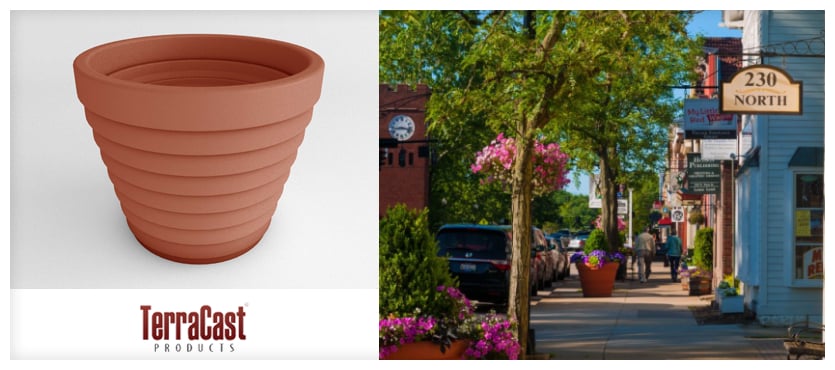As cities become more densely populated and the demand for pedestrian-friendly spaces grows, urban planners and local governments must seek innovative solutions that promote safety and mobility. Walkability isn’t just about adding sidewalks—it’s about designing environments that invite people to linger, interact, and move comfortably through urban spaces. Walkable cities prioritize pedestrians by designing spaces that encourage foot traffic, reduce vehicle congestion, and foster vibrant community interactions. Resin planters and street furniture play a key role in shaping these environments, making public areas more enjoyable, practical, and visually appealing.
Why Walkability Matters in Urban Planning
Walkable cities offer numerous advantages, both for residents and local businesses. Increased pedestrian-friendly spaces contribute to public health by encouraging physical activity, reducing pollution levels from vehicle emissions, and boosting local economies by attracting foot traffic to commercial areas. However, for a city to be truly walkable, it must have more than just sidewalks—it must be designed to be inviting, safe, and comfortable for pedestrians.
Traditional cityscapes dominated by wide roads and minimal pedestrian infrastructure create barriers to walkability. People are more likely to walk in areas that feel engaging, shaded, and structured with clear pathways. This is where resin planters and durable street furniture come into play, helping to define pedestrian-friendly zones while adding beauty and function.
How Resin Planters Enhance Walkability
Creating Natural Barriers for Safety: One of the biggest concerns in pedestrian-friendly design is ensuring that walkways and seating areas are protected from vehicles. Resin planters offer an excellent solution as natural barriers, preventing cars from encroaching on pedestrian spaces while adding greenery and aesthetic appeal. Unlike heavy concrete barriers, resin planters are lightweight and easy to install while still offering strong protection when strategically placed.
Defining Walkable Zones: In urban environments, planters can help delineate pedestrian walkways, outdoor dining areas, and public gathering spaces. By placing large, commercial resin planters along sidewalks or near intersections, cities can create visual cues that naturally guide pedestrian movement and prevent foot traffic from spilling into busy streets.
Reducing Urban Heat and Improving Air Quality: Resin planters filled with greenery contribute to a city’s overall air quality by filtering pollutants and providing oxygen. They also help mitigate the urban heat island effect, where concrete and asphalt absorb and retain heat, making cities significantly warmer. Trees and plants housed in resin planters provide much-needed shade, making walking more comfortable, especially in warmer climates.
The Role of Street Furniture in Pedestrian-Friendly Design
Encouraging Social Interaction: Well-placed resin benches and seating transform sidewalks, plazas, and public spaces into areas where people can rest, socialize, and enjoy their surroundings. Seating options encourage longer pedestrian engagement, making urban areas more welcoming and dynamic.
Enhancing Accessibility: Walkable cities must accommodate all residents, including those with mobility challenges. Comfortable, well-spaced seating and resting areas help ensure that elderly individuals, families with small children, and people with disabilities can navigate urban areas with ease.
Low-Maintenance, High-Durability Solutions: Urban furniture and planters must withstand high-traffic environments, exposure to the elements, and potential vandalism. Resin products are highly durable, requiring minimal maintenance compared to traditional materials like metal, which can rust, or wood, which may rot or splinter. Resin is also resistant to graffiti and can be cleaned easily with pressure washing, ensuring that public spaces remain visually appealing without costly maintenance.
Applications of Resin Planters and Street Furniture in Urban Walkability
Resin planters and street furniture can be strategically placed throughout cities to enhance walkability in various ways. Sidewalk beautification is one of the most effective uses, as placing planters along sidewalks softens the urban landscape, making streets more inviting while defining pedestrian pathways. These planters also serve as traffic-calming measures, helping to slow down vehicle traffic in shared spaces and encouraging safer driving habits.
Many cities are transforming underutilized street corners and parking spaces into small parklets, equipped with resin furniture and planters, creating green pedestrian-friendly havens. Transit stops and public spaces also benefit from durable seating and planters, improving comfort and encouraging more people to use public transportation. By integrating these elements into urban landscapes, cities create multifunctional spaces that are safer, greener, and more inviting.
Designing Walkable Cities with Resin Solutions
Creating walkable cities requires a combination of smart urban planning and durable infrastructure solutions. Resin planters and street furniture play a crucial role in defining pedestrian spaces, improving safety, and enhancing overall aesthetics while remaining low-maintenance and weather-resistant.
For municipalities, urban planners, and businesses looking to create inviting, pedestrian-friendly environments, TerraCast® resin products offer a sustainable and durable solution. With their commitment to quality, customization, and long-lasting materials, TerraCast® continues to be a leader in innovative urban design solutions. To learn more about how they can transform walkways in your city, contact them today.

